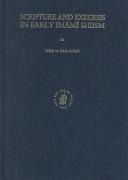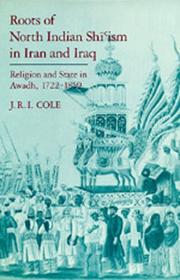| Listing 1 - 6 of 6 |
Sort by
|
Book
ISBN: 0585088500 9780585088501 1438411111 Year: 1988 Publisher: [Place of publication not identified] State University of New York Press
Abstract | Keywords | Export | Availability | Bookmark
 Loading...
Loading...Choose an application
- Reference Manager
- EndNote
- RefWorks (Direct export to RefWorks)
Book
ISBN: 0585078491 9780585078496 1438414269 Year: 1989 Publisher: [Place of publication not identified] State University of New York Press
Abstract | Keywords | Export | Availability | Bookmark
 Loading...
Loading...Choose an application
- Reference Manager
- EndNote
- RefWorks (Direct export to RefWorks)
Shåi°ah --- Islam --- Religion --- Philosophy & Religion --- Political aspects --- History
Book
ISBN: 1557864705 Year: 1995 Volume: *5 Publisher: Oxford Cambridge, Mass. Blackwell
Abstract | Keywords | Export | Availability | Bookmark
 Loading...
Loading...Choose an application
- Reference Manager
- EndNote
- RefWorks (Direct export to RefWorks)

ISBN: 9004114955 9789004114951 9789004452886 9004452885 Year: 1999 Volume: 37 Publisher: Leiden;Boston BRILL
Abstract | Keywords | Export | Availability | Bookmark
 Loading...
Loading...Choose an application
- Reference Manager
- EndNote
- RefWorks (Direct export to RefWorks)
Since the publication in 1921 of Ignaz Goldziher's Die Richtungen der islamischen Koransauslegung , which includes a discussion of Imāmī exegesis, no comprehensive work on this topic has appeared. In the intervening years, important Imāmī commentaries on the Qur'ān have become available, making possible a reappraisal of the subject. The present study aims to contribute to this task, primarily by examining the features and methods of Imāmī exegesis. Principally, it offers a description and analysis of the major tenets of Imāmī doctrine, as reflected in the earliest Imāmī works of exegesis and related sources, up to the Major Occultation of the twelfth Imam in 329/941. These include, among others, the belief in a primordial covenant between God and the Shī'a, and the superhuman and mystical qualities with which the Imams were graced, such as their God-given, infinite knowledge, their intercession on behalf of their community, their immunity from sin and error, etc. Other tenets relate to the attitude of Imāmī Shī'ism to its enemies, e.g. the duty to denigrate and dissociate from them. These and similar ideas are constant motifs in Imāmī exegesis, and are linked time and again with various Qur'ānic verses. Relying on classical and modern Arabic sources, Sunnī and Shī'ī alike, as well as on a wide range of western research, Meir Bar-Asher sheds new light on the Imāmī methods of exegesis and on the principal Imāmī doctrines as reflected in the early Imāmī exegetical corpus.
Qur'an --- Commentaries --- History and criticism --- Criticism, interpretation, etc --- Imams (Shiites) - History. --- Shåi°ah - History. --- Imams (Shiites) --- Shiism --- History --- Imams --- Shīʻah --- Shiites --- Imamites --- Shia --- Twelvers (Islam) --- Islamic sects --- Alids --- Coran --- Imāms (chiites) --- Chiisme --- Critique, interprétation, etc. --- 10e siècle --- 11e siècle --- Histoire

ISBN: 0520056418 0585159351 Year: 1988 Volume: 6 Publisher: Berkeley, Calif. University of California Press
Abstract | Keywords | Export | Availability | Bookmark
 Loading...
Loading...Choose an application
- Reference Manager
- EndNote
- RefWorks (Direct export to RefWorks)
In this pioneering study of the Twelver Shi'i branch of Islam prevalent in Iraq and Iran, J. R. I. Cole traces the influence of Shi'i rule on the development of religious communalism and conflict in the North Indian State of Awadh (Oudh). He also examines the relationship of the Shi'i clergy to the state and the clerical reaction to British imperialism and capitalism. Based on research in rare manuscripts and in archives, the book reveals that the Shi'i clergy advocated policies that caused resentment among Sunnis and Hindus, thereby promoting religious communalism and setting the stage for modern communal conflict. The Shi'i learned men took government posts in support of Awadh's Shi'i nawabs and shahs Awadh state support, in turn, helped transform Shi'ism from a persecuted "sect" to a dominant, if still minority, religious establishment. Sociologically, the book draws attention to the specific role of the state in defining "sect" and "church." It also argues the importance of class divisions within the Shi'i community, showing that the dominant clerical ideology was often not accepted by the laboring strata. Cole's study supports the view that Muslim communalism in Northern India had genuine historical roots and was not simply an elite strategy of modern Muslim politicians. Contrary to the arguments of some writers and to the image projected by Iran's current ayatullahs, he claims that most Shi'i clergy did not play a role of opposition to the state.
Shīʻah --- Islam and state --- Shåi°ah --- Islam --- Religion --- Philosophy & Religion --- History. --- History --- Oudh (India) --- Ethnic relations. --- Religion. --- Mosque and state --- State and Islam --- Imamites --- Shia --- Shiism --- Twelvers (Islam) --- Awadh (India) --- Oude (india) --- History of Asia --- anno 1700-1799 --- anno 1800-1899 --- Iraq --- Iran --- State, The --- Ummah (Islam) --- Islamic sects --- Alids --- United Provinces of Agra and Oudh (India) --- Avadha (India) --- Oude (India) --- Shīʻah
Book
ISBN: 9780748633302 9780748633319 9780748631902 9780748678334 0748633316 0748633308 0748631909 0748678336 1336017139 Year: 2013 Publisher: Edinburgh : Edinburgh University Press,
Abstract | Keywords | Export | Availability | Bookmark
 Loading...
Loading...Choose an application
- Reference Manager
- EndNote
- RefWorks (Direct export to RefWorks)
As many as 40 different Shi`i groups existed in the 9th and 10th centuries yet only 3 forms have survived. Why is Twelver Shi`ism one of themAs the established faith in modern Iran, the majority faith in Iraq and areas in the Gulf and with its adherents forming sizeable minorities elsewhere in the region, Twelver Shi'ism is arguably the most successful branch of Shi'ism. Andrew J. Newman chronicles the progression of Twelver Shiism, exploring the numerous external challenges and internal disagreements that marked the lives of believers in pockets across the Middle East to the early 18th century. During this time, from the 13th to the 15th century especially, with scholarly activity and the availability of earlier key texts of the faith limited, the region's many millenarian doctrines and movements threatened its demise. Only by the late 17th century was Twelver Shiism's survival assured, both in Iran and elsewhere in the region.
Shiah --- 297 <09> --- History. --- Islam. Mohammedanisme--Geschiedenis van ... --- Doctrines --- Shīʻah --- Imams (Shiites) --- Imams (Shiites). --- Shīʻah / Doctrines / History. --- Shīʻah / History. --- Imamiten. --- Geschichte 632-1722. --- Shīʻah / Doctrines / History --- Shīʻah / History --- History --- Imamiten --- Shīʻah --- Chiisme --- Imāms (chiisme) --- Histoire. --- Shåi°ah --- Islam. Mohammedanisme--Geschiedenis van .. --- Doctrines&delete& --- Imams --- Shiites --- Islam. Mohammedanisme--Geschiedenis van . --- Islam. Mohammedanisme--Geschiedenis van --- Imāms (chiisme)
| Listing 1 - 6 of 6 |
Sort by
|

 Search
Search Feedback
Feedback About UniCat
About UniCat  Help
Help News
News